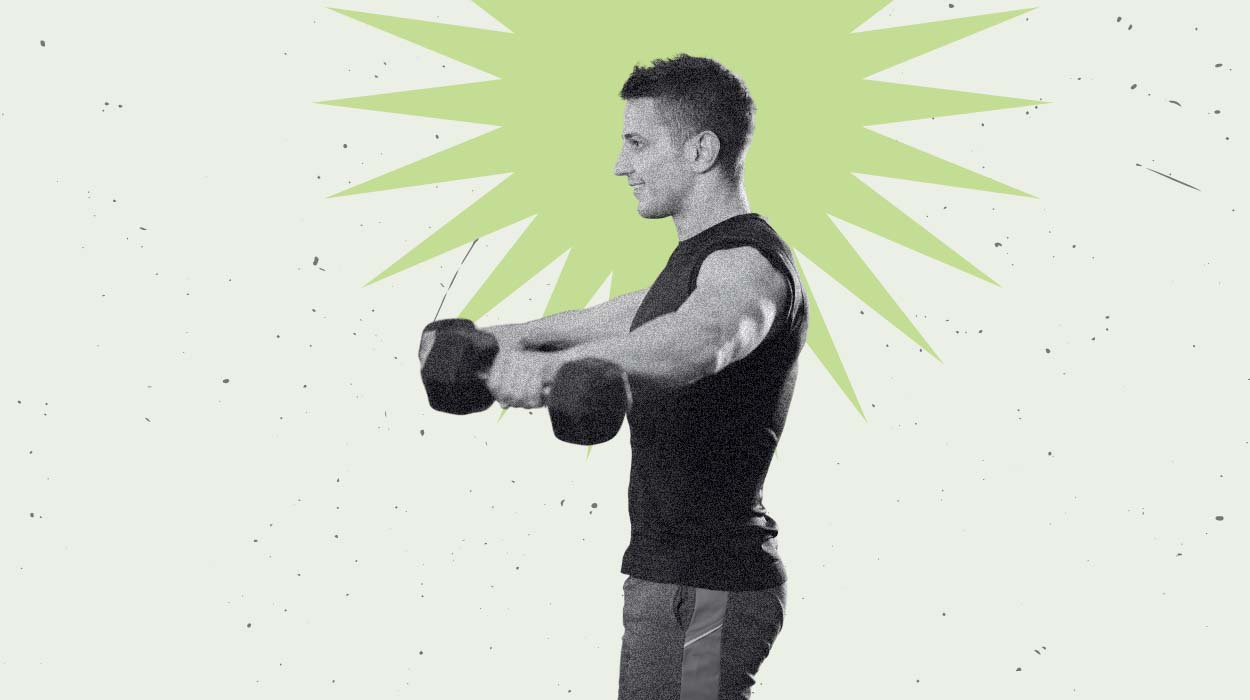
If you’re looking to improve your performance at the gym, then you understand how important your front deltoids are. They are essential for performing most press, hinge, and squat exercises– all of which help build a balanced and effective physique.
Did you know that the anterior deltoid (or front delt) is one of the three muscle groups that make up the deltoid muscles? Not only that, but this one in particular, is responsible for moving the upper arm in front of your body and over your head, which is a movement most people repeat hundreds of times throughout their day.
Neglecting the development of your front delts can lead to severe muscle imbalances, reduced mobility, and reduced performance in and out of the gym.
In this article, we’ll be discussing some of the most effective front-line workouts and their benefits.
Front Deltoid Exercises For Upper Body Development
The front deltoids are one of the most important muscles in the upper body and help boost shoulder strength, mobility, stability, and posture. They are vital for the execution of numerous exercises and the overall development of the body.
List front delt workout:
Without equipment:
- Pike push-up.
- Pseudo-planche push-up.
- Hindu push-up.
- Consecutive shoulder taps.
- Planche lean or hold.
With equipment:
Front Delt Exercises Without Equipment
Training your front delt exercises without equipment is equally as effective as with equipment. Here are five front-delt workouts without equipment. Here are five front-delt workouts without needing equipment.
Pike Push-Ups
The pike pushup is a calisthenics exercise that focuses on shoulder flexion and engages the upper chest. The exercise targets shoulder muscles and can enhance hip and hamstring flexibility over time.
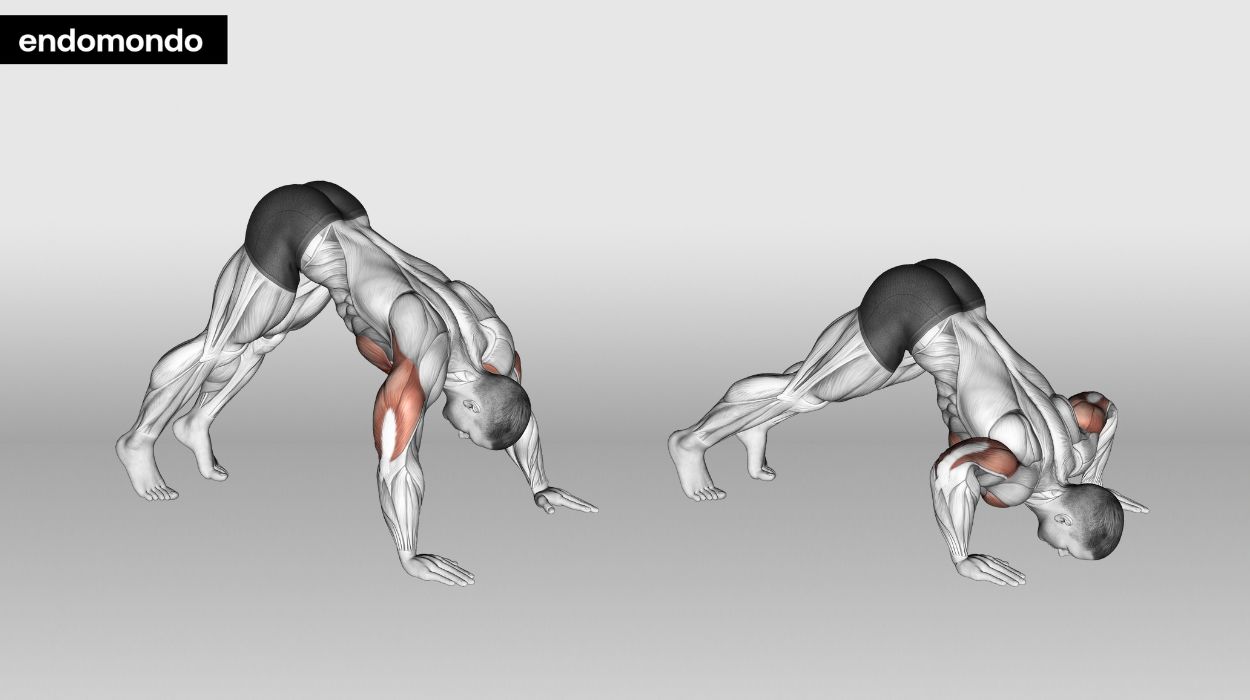
How to do:
- Start in a standard pushup position.
- Hinge at the waist to transition into a downward-dog yoga pose.
- Lower your body, letting your shoulders lead, until your head touches the floor.
- Press up until your arms are fully locked.
- This completes one pike push-up.
Tips:
- Keep your hips high and heels low to maintain a strong inverted V shape.
- Lower your head towards the floor, leading with your shoulders, not your elbows.
- Move slowly and control your descent and ascent for maximum muscle engagement.
Optimal Sets and Reps: Aim for 3 to 4 sets of 6 to 10 reps each.
Pseudo-Planche Push Up
The Pseudo-Planche Push Up is an advanced variation of the regular pushup with the
wrists externally rotated. This simple change shifts most of the load of the exercise from the chest to the anterior and medial deltoid muscles, and the long head of the triceps.
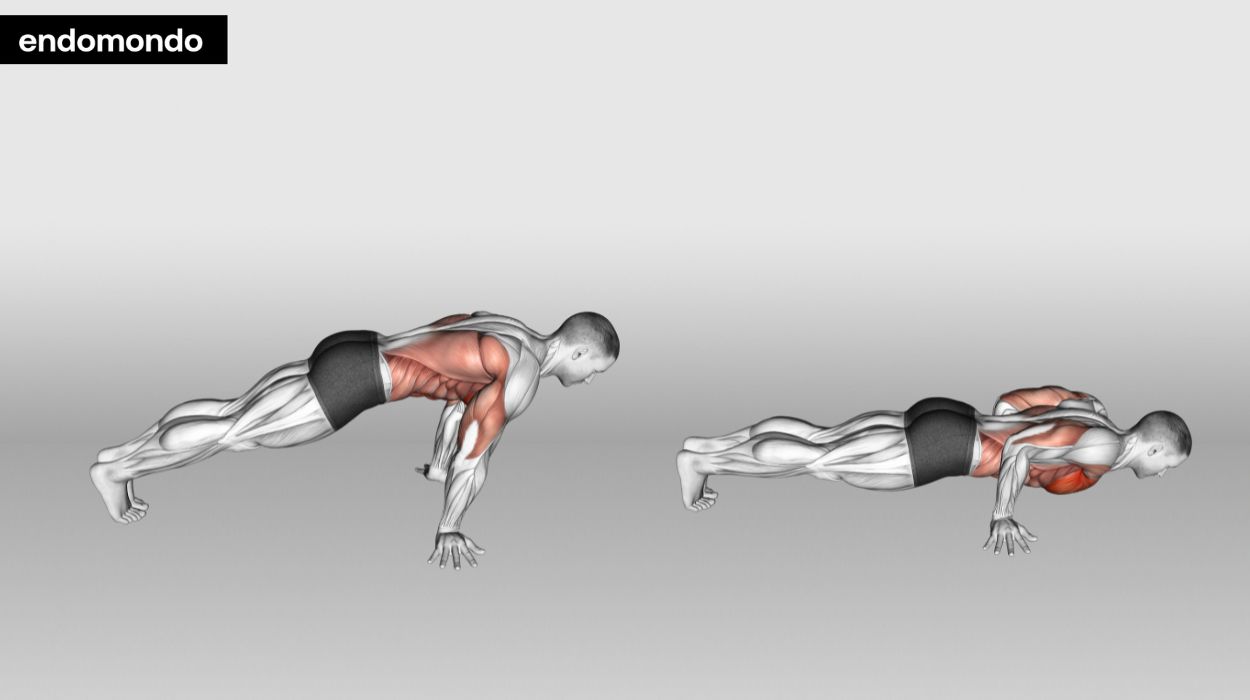
How to do:
- Lean forward during the exercise to shift more body weight onto the shoulder muscles.
- The Pseudo-planche pushup also enhances core strength.
- It improves wrist flexibility as a secondary benefit.
Tips:
- Position your hands slightly turned out and closer to your waist for proper form.
- Keep your body straight and core engaged to maximize muscle activation.
- Shift your weight forward over your hands to intensify shoulder engagement.
Optimal Sets and Reps: Perform 3 to 4 sets of 8 to 12 reps each.
Hindu Pushups
Hindu Pushups are an advanced push-up variation that extends the basic exercise with
a bigger range of motion. The goal of the exercise is to improve spine flexibility shoulder strength and mobility.
How to do:
- Begin in the downward dog position with legs wide apart.
- Bend your elbows until they touch the floor.
- Push forward using your triceps, fully stretching your back.
- Finish the movement with your hands straight and arms locked out.
Tips:
- Transition smoothly from the downward dog position into the forward stretch, maintaining continuous motion.
- Keep elbows close to your body and arch your back fully during the forward motion.
- Focus on controlled movements rather than speed, emphasizing form and muscle engagement.
Optimal Sets and Reps: Aim for 3 to 4 sets of 10-15 reps each.
Consecutive Shoulder Taps
The Consecutive shoulder taps are a low-impact Planche (a gymnastic upper body strength movement) variation that targets the front deltoids.
You start the exercise by assuming the plank position– which is with your elbows and feet on the floor and your core engaged— but with your arms straight not bent.
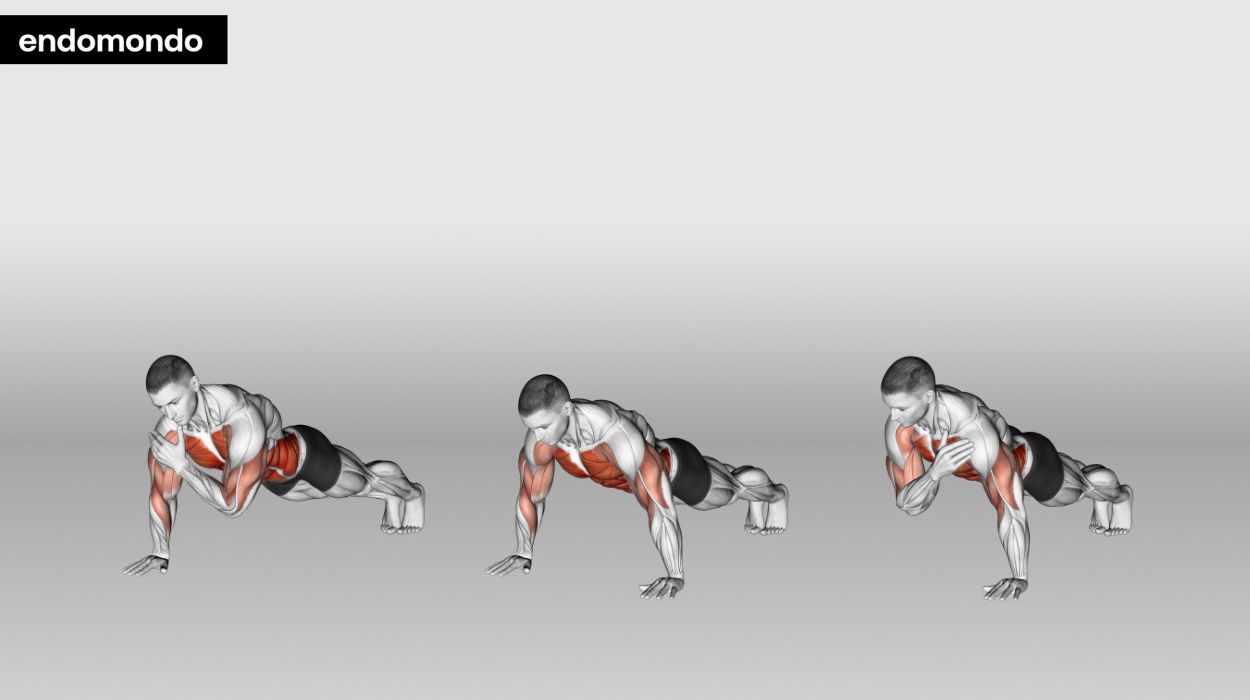
How to do:
- Begin by raising your left hand and tapping your right shoulder.
- Balance on your other three limbs while doing so.
- Next, raise your right hand and tap your left shoulder.
- Repeat this alternating shoulder tap motion.
Tips:
- Keep your core engaged and hips stable to avoid swaying side to side.
- Tap each shoulder gently and deliberately, focusing on balance and coordination.
- Maintain a steady rhythm, avoiding rushing the taps to ensure proper form.
Optimal Sets and Reps: Perform 3 sets of 10-12 taps per shoulder.
Planche Lean Or Hold
The Planche Lean is an advanced Calisthenics exercise that emphasizes the front delts, training it with a static hold.
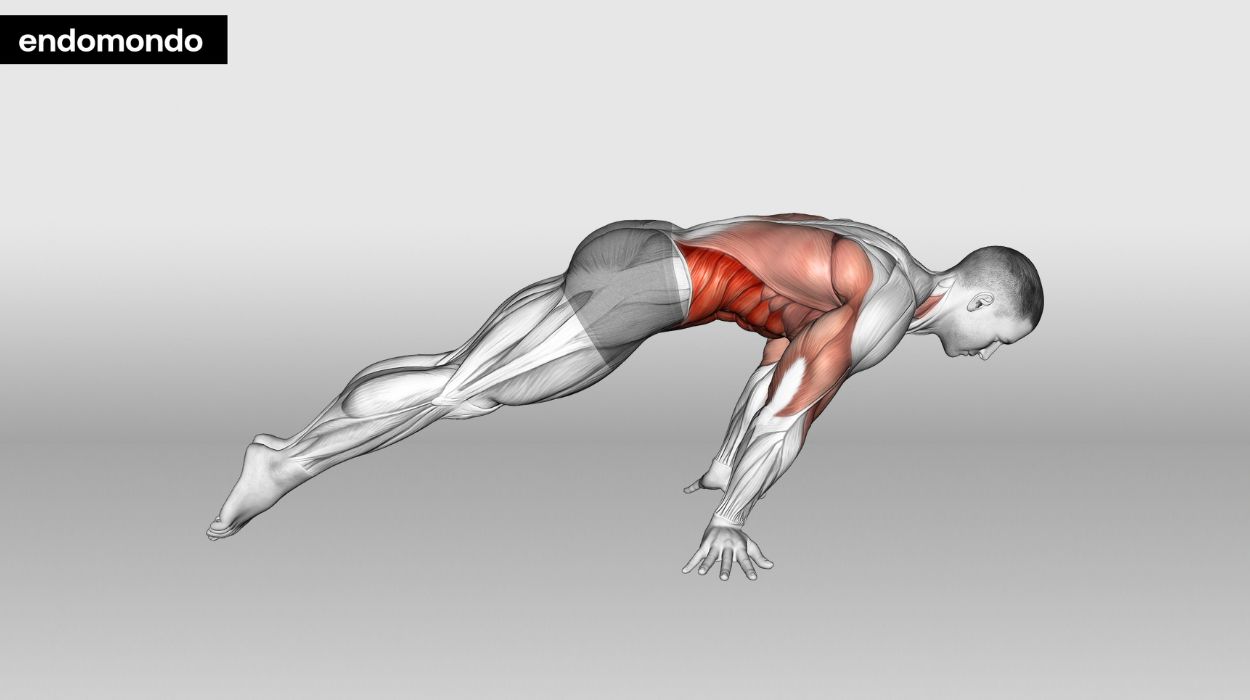
How to do:
- Start in the plank position with elbows locked and hands straight.
- Flex your abdomen, legs, and glutes, raising your scapula.
- Rock forward, maintaining the position, until body weight shifts to front delts.
- Continue until your shoulders reach their limit.
Tips:
- Keep your arms straight and elbows locked throughout the exercise for stability.
- Actively engage your core, glutes, and scapula to maintain a strong, controlled position.
- Lean forward slowly, focusing on the tension in your shoulders and arms, without compromising form.
Optimal Sets and Reps: Perform 3 to 5 sets, holding the lean for 10-20 seconds each.
Front Delt Exercises With Equipment
Resistance Band Slicers
Resistance Band Slicers are an effective resistance band shoulder exercise targeting all three heads of the deltoid muscle but placing primary emphasis on the front delts.
How to do:
- Place a resistance band on the floor and step on it, feet shoulder-width apart.
- Pick up both ends of the band, raising your hands to shoulder level.
- Swing hands outwards until you feel the tension in your side and rear delts.
- Swing your hands back in front of your shoulders.
Tips:
- Ensure your stance is stable and grip the band securely with both hands.
- Move your hands smoothly and deliberately, keeping tension in the band throughout.
- Pay attention to the side and rear delt muscles, feeling the contraction and release.
Optimal Sets and Reps: Aim for 3 to 4 sets of 12-15 repetitions.
One Arm Kettlebell Front Raise
The one-arm Kettlebell Front Raise is a variation of the dumbbell front raise performed with a kettlebell instead. It works your abdominal muscles as well but primarily targets your front delts.
How to do:
- Stand straight, feet shoulder-width apart.
- Grip the kettlebell in one hand, arm at your side.
- Raise arm forward to shoulder height, keep elbow slightly bent.
- Lower arm back down slowly and controlled.
- Repeat and switch arms after set.
Tips:
- Keep your back straight and core engaged to ensure proper form.
- Raise the kettlebell smoothly to shoulder height, then lower with control.
- Move the kettlebell using your shoulder strength, not by swinging.
Optimal Sets and Reps: Perform 3 sets of 8 to 12 reps per arm.
Barbell Overhead Press
The Barbell Overhead Press is the quintessential front delt exercise. It is a staple in most bodybuilding workouts and is performed by lifting a barbell off the rack or floor and raising it over your head until your hands are fully extended. Remember to keep your core and glutes engaged the entire time.
The Barbell Overhead Press also recruits the middle and rear delts, which act as stabilizers.
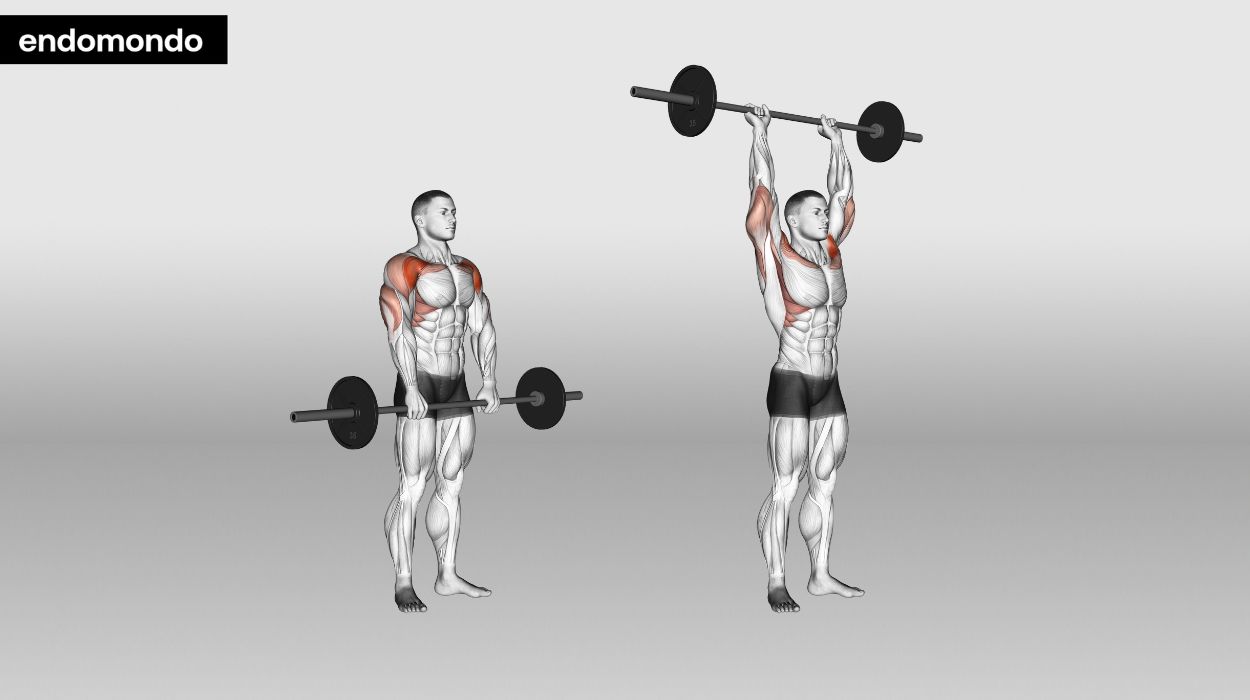
How to do:
- Stand with feet shoulder-width apart, and grip the barbell at shoulder level.
- Position the barbell in front of your shoulders, elbows facing forward.
- Press the barbell straight up, fully extending your arms overhead.
- Pause at the top, then lower back to shoulder level.
- Keep your core engaged and back straight throughout the movement.
Tips:
- Start with elbows slightly in front of the bar to engage shoulders effectively.
- Keep your feet firmly planted and core tight for stability and power.
- Press up smoothly and lower the barbell back to the starting position with control.
Optimal Sets and Reps: Aim for 3 to 4 sets of 6 to 10 reps each.
Dumbbell Arnold Press
The Arnold Press is named after the father of bodybuilding himself, Arnold Schwarzenegger. The Arnold Press is a popular exercise among bodybuilders because it targets the medial and rear deltoid muscles and the front delts.
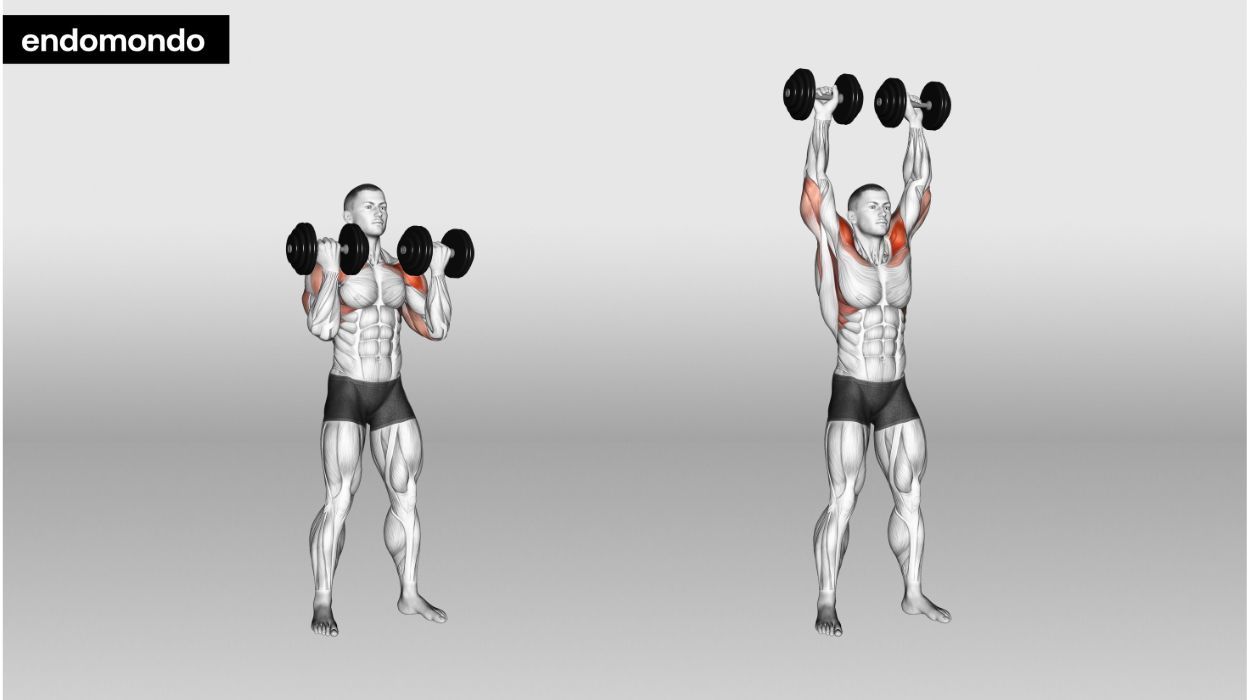
How to do:
- Stand with legs shoulder-width apart, holding dumbbells in each palm.
- Bend elbows with palms facing upwards.
- Push dumbbells above your head, rotating your palms outward as you lift.
- Pause when your hands are fully stretched above your head.
- Lower the weight, following the same path down.
Tips:
- Begin with palms facing you and elbows bent at 90 degrees.
- As you press up, rotate your arms until palms face forward at the top.
- Lift and lower the dumbbells in a controlled, fluid motion, avoiding jerky movements.
Optimal Sets and Reps: Perform 3 to 4 sets of 8 to 12 reps each.
Kettlebell Press
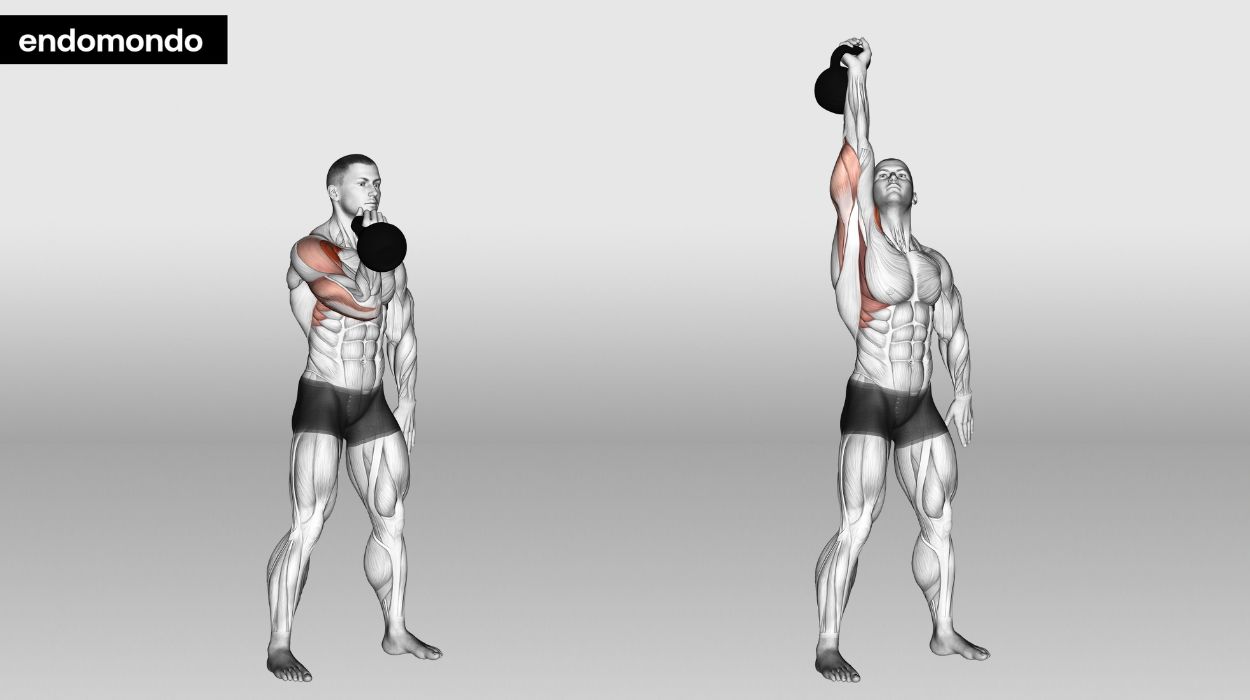
The Kettlebell Press is essentially an Arnold Press with a Kettlebell but with some simple yet important differences. Because of the Kettlebell’s unique weight distribution, your obliques, glutes, and abdominal muscles work overtime to balance the weight as you press the kettlebell above your head. Then lower the weight, guiding it in the same way you lifted it.
How to do:
- Start with feet shoulder-width apart, holding the kettlebell at shoulder level.
- Grip the kettlebell firmly with the palm facing forward.
- Press the kettlebell straight overhead, extending the arm fully.
- Keep wrist straight and core engaged.
- Lower back to shoulder level with control.
Tips:
- Ensure your wrist stays straight and firm throughout the movement.
- Tighten your core and glutes for stability as you press the kettlebell.
- Keep your elbow under the kettlebell and move it in a straight vertical line.
Optimal Sets and Reps: Perform 3 to 4 sets of 8 to 12 reps per arm.
Benefits Of Front Delt Workouts
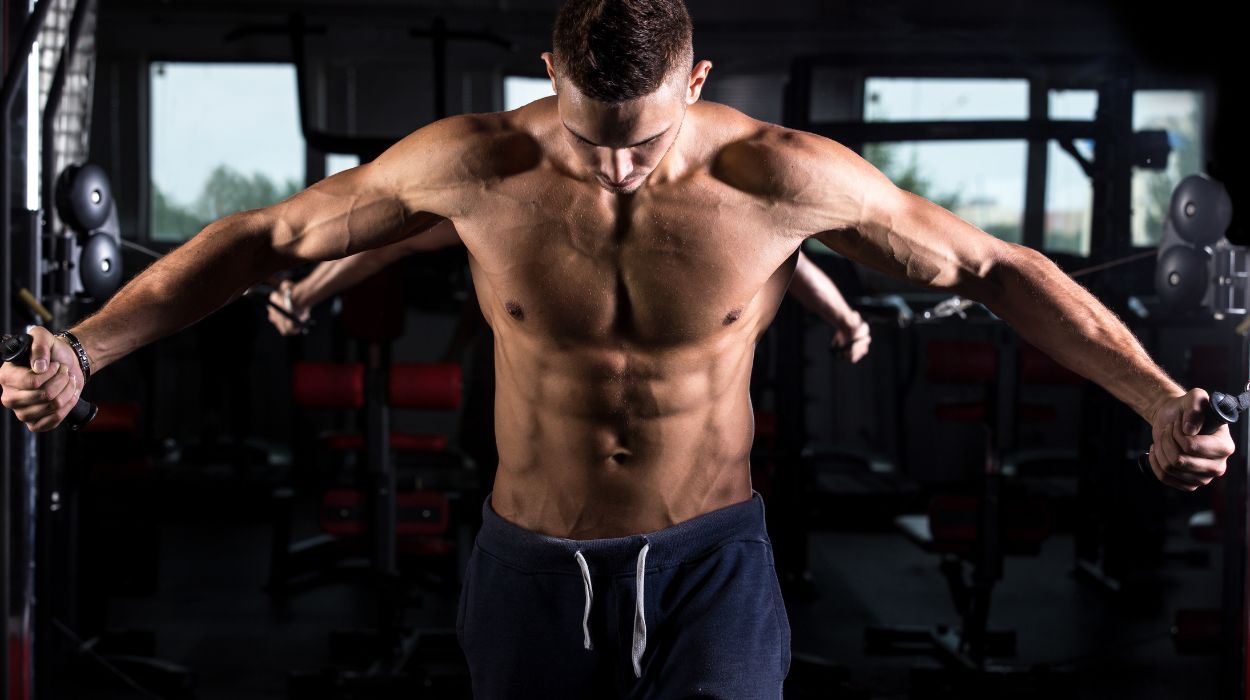
Performing front deltoid exercises with or without equipment offers a range of benefits. Here’s a deeper look at the benefits of front delt exercises.
Correct Muscle Imbalances And Posture
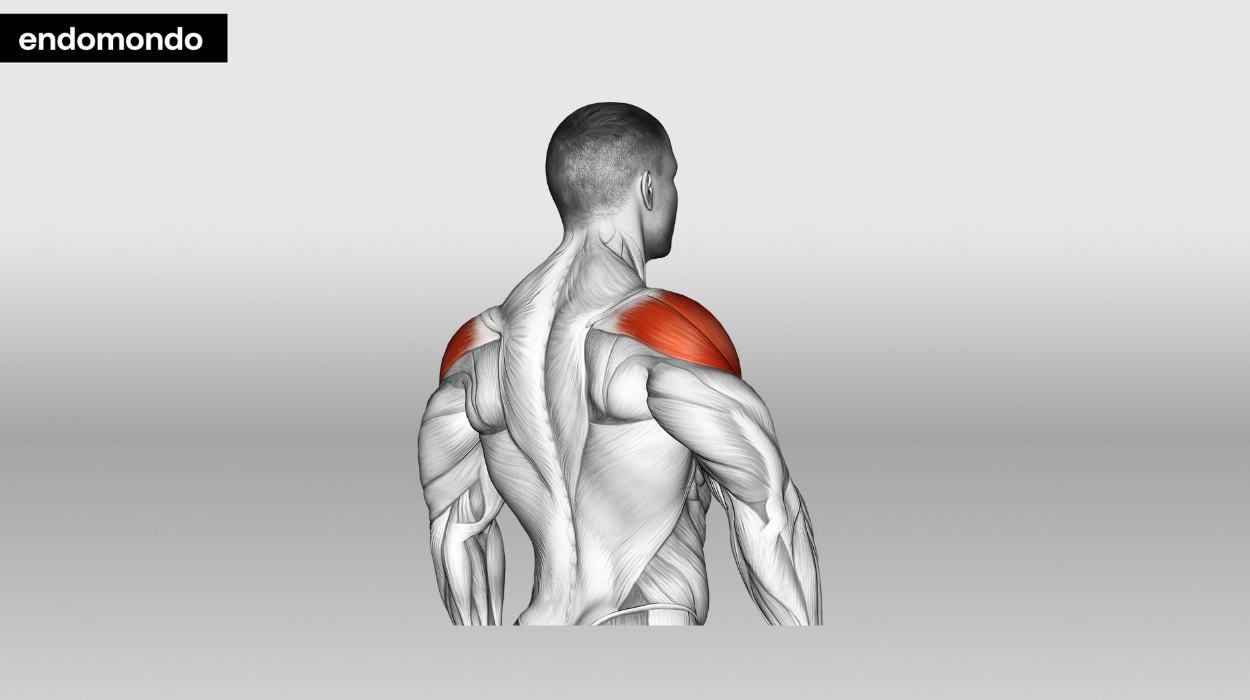
Over and under-training certain areas of the deltoid muscles are common causes of muscular and postural imbalances in the body. The most prevalent of these imbalances is a forward slouch or hunch common in bodybuilders who neglect training their latissimus dorsi[1] (back) and rear deltoid [2] muscles.
Having developed front, side, and rear deltoids, as well as rotator cuffs helps reduce the risk of muscular imbalances and postural problems.
Reduce Risks Of Injuries
By exercising the front deltoids, through the incline dumbbell press, shoulder press, and other related exercises, you can reduce the risk of injury when performing shoulder, chest, and barbell squat variations.
Having stronger front shoulder muscles also gives you better control during the eccentric and concentric portions of an exercise, making it easier to avoid potentially serious injuries.
Strengthen Rotator Cuffs
A strong and well-developed front deltoid complements the middle and rear deltoids and strengthens the entire shoulder complex, placing less stress on the rotator cuff muscles [3].
The rotator cuff muscles are a group of four muscles responsible for stabilizing the shoulder joint. Incurring an injury to them could mean reduced muscular performance, joint mobility, and chronic pain.
Enhance Performance
The front or anterior deltoids are routinely recruited when performing various press and hinge exercises throughout your workout.
For example, the incline bench press requires the front delts to act as stabilizers, making them a secondary target of the exercise. Lower body development exercises like the deadlift and front squat also require strong front delts to execute.
Developing them through exercises like the pike pushup, resistance band slicer, or band overhead press can help boost your all-around performance.
Tips For Front Delt Workouts
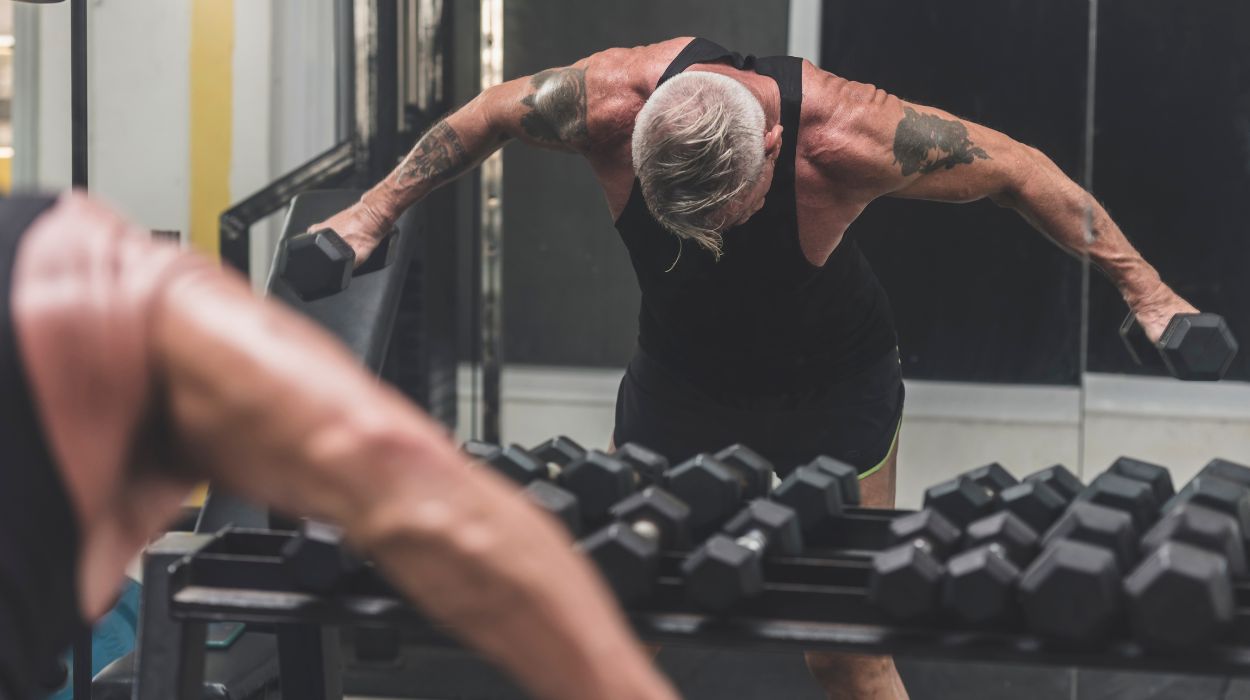
Here are some key tips to consider while doing the front delt workouts:
- Start weighted exercises at a safe weight and progress slowly.
- Look up easier variations of bodyweight exercises.
- Focus on form over performance.
- Perform your front delt exercises after you’ve finished your chest workout.
- Eat a healthy breakfast and maintain a good diet to see the best results.
- Choose low-impact shoulder exercises like consecutive shoulder taps to increase tone, which can also help you to lose weight and get a flat stomach.
Conclusion
Front delt exercises target and develop the anterior deltoid, which is arguably the most used muscle in the shoulder. Strengthening the muscle improves posture, and overall performance, prevents injuries, and preserves the rotator cuff.
There are a plethora of great front-duty workouts to choose from based on your equipment and strength level. Regardless of your choice, you will see steady growth if you exercise consistently and eat a good diet.
Frequently Asked Questions
Front delt workouts are exercises that build the front or anterior portion of the deltoid muscle.
Yes. Front delt workouts can help balance out the shoulder, improving your overall posture and shoulder stability.
Stronger front delts make it easier to handle weight in the overhead position and avoid potentially serious injuries.
Yes. The rotator cuff is put under a lot of stress when the shoulder is imbalanced. Building a strong shoulder with great front delt workouts helps you mitigate that risk.
Yes, they can. A strong front delt is required to perform most chest presses, deadlifts, front squats, and other compound exercises.
No, you do not. There are tons of bodyweight front-field workouts, some of which are included above.
Resources
- Jeno SH;Varacallo M (2023). Anatomy, Back, Latissimus Dorsi. [online] Available at: https://pubmed.ncbi.nlm.nih.gov/28846224/.
- Adel Elzanie and Varacallo, M. (2023). Anatomy, Shoulder and Upper Limb, Deltoid Muscle. [online] Nih.gov. Available at: https://www.ncbi.nlm.nih.gov/books/NBK537056/.
- Smita Maruvada, Madrazo-Ibarra, A. and Varacallo, M. (2023). Anatomy, Rotator Cuff. [online] Nih.gov. Available at: https://www.ncbi.nlm.nih.gov/books/NBK441844/.




